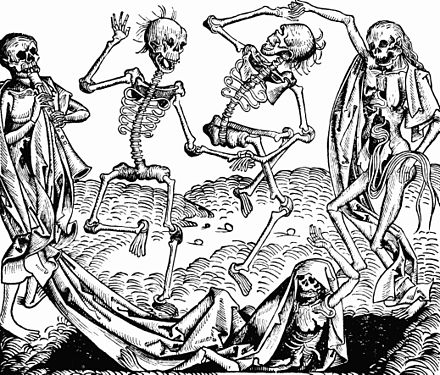The Black Death
Today in Labor History June 11, 1352, a series of trials were held against laborers from Wiltshire, England. The authorities accused them of violating a 1349 ordinance requiring all laborers to accept the wages they had received in 1346. This conflict stemmed directly from the horrors of the Black Death, which had killed 75-200 million Europeans between 1347 and 1351, or 30-60% of the entire continent’s population. In some regions of Europe (e.g., France, Spain, Italy) as many as 80% of the population died. However, the labor shortage that arose from all the deaths did potentially increase workers’ power. Many peasants used the opportunity to demand better conditions or to leave their landlords property entirely. The 1349 ordinance was an attempt to force laborers to stay where they were and continue working for their desperate landlords.
Wat Tyler’s Rebellion
Today in Labor History June 11, 1381: Wat Tyler’s Rebellion. Tyler led a Peasant revolt in England, from May to June 15, 1381. The uprising began in response to a new poll tax. However, Tyler called for property to be held in common and equality for all. The peasants also wanted the right to choose their employer, rather than to be tied to a specific landlord. The rebellion contributed to the end of serfdom.
Tyler’s Rebellion has been referenced in many works of music and literature. He is the protagonist in Pierce Egan the Younger’s novel “Wat Tyler, or the Rebellion of 1381 (1841),” a radical text published as a propaganda piece during the Chartist movement, as an argument for a republican government. Charles Dickens invokes Wat Tyler’s name in “Bleak House” (1853). Tyler also appears as a sympathetic hero in “A Dream of John Ball” (1888) by the socialist writer William Morris. And he appears in Melville’s “Redburn” and in Twain’s “A Connecticut Yankee in King Arthur’s Court.”
1837: Broad Street Riot
Today in Labor History June 11, 1837: The Broad Street Riot occurred in Boston, between Irish Americans and Yankee firefighters. As shocking as this might seem to today’s readers, it was relatively common in the mid- to late-1800s. First, fire departments were generally volunteer or private organizations made up of ethnically similar people. Secondly, Nativist and anti-Catholic sentiment was rampant, which led to regular fights between “native” or Protestant fire crews and immigrant Catholic-Irish crews. Such a fight plays prominently in my historical novel, “Anywhere But Schuylkill.” This phenomenon is discussed in Noel Ignatiev’s excellent book, “How the Irish Became White.”
During the Broad Street Riot, roughly 800 people brawled, with 10,000 spectators egging them on. The firefighters vandalized nearby homes and businesses and beat residents (mostly Irish). While injuries were severe and pervasive, nobody died. The mayor had to call in the state militia to put down the riot. In the aftermath, Boston created its first municipal police and fire departments.
1920s
Today in Labor History June 11, 1925: Drunken cops attacked miners striking against British Empire Steel Corporation (BESCO) in Cape Breton, Nova Scotia. They killed 1 miner and injured many others, causing a riot in which strikers looted and burned the company stores and drove the police out of town. The government then deployed 2,000 soldiers to suppress the strike, the largest peacetime deployment of the Canadian Army for an internal conflict since the Northwest Rebellion (1885). Members of the union vowed never to work again on June 11, in honor of Bill Davis, the miner who died. Cape Breton now celebrates Davis Day each year. Since then, Davis Day has become more of a workers’ memorial day, remembering all those who died in Nova Scotia’s mines, like the 75 men killed in the Springhill mine collapse (1958), and the 26 non-union miners killed in the Westray explosion (1992).
1950s-1960s
Today in Labor History June 11, 1956: The Gal Oya riots against minority Sri Lankan Tamils began in Ceylon (now known as Sri Lanka). Officially, 150 people died, but the totals may actually be much higher. This was the first organized pogrom against Sri Lankan Tamils in Ceylon. The worst of the violence took place in the Gal Oya valley. There, Sinhalese colonists and employees of the Gal Oya Development Board stole government vehicles, dynamite and weapons and used them to massacre Tamils.
Today in Labor History June 11, 1963: Alabama Governor George Wallace physically blocked the doors of Foster Auditorium at the University of Alabama with his own body in an attempt to block two black students from attending that school. Later in the day, federalized National Guard troops allowed them to register.
1970s-2000s
Today in Labor History June 11, 1974: A labor dispute at the Chrysler Truck Facility erupted into a spontaneous wildcat strike lasting from June 11 through June 14. Two Dodge Truck strikers wrote, “[we wanted] to free ourselves from the tyranny of the workplace; stop being forced to sell our labor to others; stop others from having control over our lives.”
Today in Labor History June 11, 2002: Earth First! and IWW activists Judi Bari and Darryl Cherney won $4.4 million in a false-arrest lawsuit against Oakland police and the FBI. They had been arrested for blowing up their own car while they were in it. The jury unanimously found that six of the seven FBI and OPD defendants had deliberately framed Bari and Cherney in an effort to crush Earth First! and chill participation in Redwood Summer.








Pingback: Today in Labor History June 14 - Marshall Law
Pingback: Today in Labor History March 2 - Michael Dunn